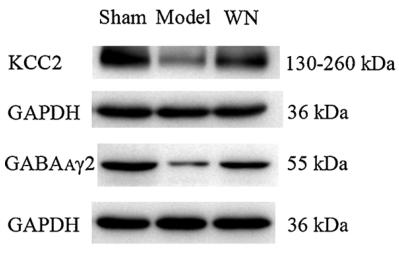GABA A Receptor gamma 2 Antibody - #DF6583
| Product: | GABA A Receptor gamma 2 Antibody |
| Catalog: | DF6583 |
| Description: | Rabbit polyclonal antibody to GABA A Receptor gamma 2 |
| Application: | WB IHC |
| Cited expt.: | WB |
| Reactivity: | Human, Mouse, Rat |
| Prediction: | Pig, Bovine, Horse, Sheep, Rabbit, Dog |
| Mol.Wt.: | 55kDa; 54kD(Calculated). |
| Uniprot: | P18507 |
| RRID: | AB_2838545 |
Related Downloads
Protocols
Product Info
*The optimal dilutions should be determined by the end user. For optimal experimental results, antibody reuse is not recommended.
*Tips:
WB: For western blot detection of denatured protein samples. IHC: For immunohistochemical detection of paraffin sections (IHC-p) or frozen sections (IHC-f) of tissue samples. IF/ICC: For immunofluorescence detection of cell samples. ELISA(peptide): For ELISA detection of antigenic peptide.
Cite Format: Affinity Biosciences Cat# DF6583, RRID:AB_2838545.
Fold/Unfold
CAE 2; CAE2; ECA 2; ECA2; GABA(A) receptor gamma 2; GABA(A) receptor subunit gamma 2; GABA(A) receptor subunit gamma-2; GABRG 2; GABRG2; Gamma aminobutyric acid (GABA) A receptor gamma 2; Gamma aminobutyric acid A receptor gamma 2; Gamma aminobutyric acid receptor gamma 2 subunit; Gamma-aminobutyric acid receptor subunit gamma-2; GBRG2_HUMAN; GEFSP 3; GEFSP3;
Immunogens
A synthesized peptide derived from human GABA A Receptor gamma 2, corresponding to a region within N-terminal amino acids.
- P18507 GBRG2_HUMAN:
- Protein BLAST With
- NCBI/
- ExPASy/
- Uniprot
MSSPNIWSTGSSVYSTPVFSQKMTVWILLLLSLYPGFTSQKSDDDYEDYASNKTWVLTPKVPEGDVTVILNNLLEGYDNKLRPDIGVKPTLIHTDMYVNSIGPVNAINMEYTIDIFFAQTWYDRRLKFNSTIKVLRLNSNMVGKIWIPDTFFRNSKKADAHWITTPNRMLRIWNDGRVLYTLRLTIDAECQLQLHNFPMDEHSCPLEFSSYGYPREEIVYQWKRSSVEVGDTRSWRLYQFSFVGLRNTTEVVKTTSGDYVVMSVYFDLSRRMGYFTIQTYIPCTLIVVLSWVSFWINKDAVPARTSLGITTVLTMTTLSTIARKSLPKVSYVTAMDLFVSVCFIFVFSALVEYGTLHYFVSNRKPSKDKDKKKKNPAPTIDIRPRSATIQMNNATHLQERDEEYGYECLDGKDCASFFCCFEDCRTGAWRHGRIHIRIAKMDSYARIFFPTAFCLFNLVYWVSYLYL
Predictions
Score>80(red) has high confidence and is suggested to be used for WB detection. *The prediction model is mainly based on the alignment of immunogen sequences, the results are for reference only, not as the basis of quality assurance.
High(score>80) Medium(80>score>50) Low(score<50) No confidence
Research Backgrounds
Ligand-gated chloride channel which is a component of the heteropentameric receptor for GABA, the major inhibitory neurotransmitter in the brain. Plays an important role in the formation of functional inhibitory GABAergic synapses in addition to mediating synaptic inhibition as a GABA-gated ion channel. The gamma2 subunit is necessary but not sufficient for a rapid formation of active synaptic contacts and the synaptogenic effect of this subunit is influenced by the type of alpha and beta subunits present in the receptor pentamer (By similarity). The alpha1/beta2/gamma2 receptor and the alpha1/beta3/gamma2 receptor exhibit synaptogenic activity. The alpha2/beta2/gamma2 receptor exhibits synatogenic activity whereas the alpha2/beta3/gamma2 receptor shows very little or no synaptogenic activity (By similarity). Functions also as histamine receptor and mediates cellular responses to histamine (By similarity).
Glycosylated.
Palmitoylated by ZDHHC3/GODZ; which may affect presynaptic clustering and/or cell surface stability.
Cell junction>Synapse>Postsynaptic cell membrane>Multi-pass membrane protein. Cell membrane>Multi-pass membrane protein. Cell projection>Dendrite. Cytoplasmic vesicle membrane.
The extracellular domain contributes to synaptic contact formation.
Belongs to the ligand-gated ion channel (TC 1.A.9) family. Gamma-aminobutyric acid receptor (TC 1.A.9.5) subfamily. GABRG2 sub-subfamily.
Research Fields
· Environmental Information Processing > Signaling molecules and interaction > Neuroactive ligand-receptor interaction.
· Human Diseases > Substance dependence > Morphine addiction.
· Organismal Systems > Nervous system > Retrograde endocannabinoid signaling. (View pathway)
· Organismal Systems > Nervous system > GABAergic synapse.
References
Application: WB Species: Rat Sample:
Application: IF/ICC Species: Rat Sample:
Restrictive clause
Affinity Biosciences tests all products strictly. Citations are provided as a resource for additional applications that have not been validated by Affinity Biosciences. Please choose the appropriate format for each application and consult Materials and Methods sections for additional details about the use of any product in these publications.
For Research Use Only.
Not for use in diagnostic or therapeutic procedures. Not for resale. Not for distribution without written consent. Affinity Biosciences will not be held responsible for patent infringement or other violations that may occur with the use of our products. Affinity Biosciences, Affinity Biosciences Logo and all other trademarks are the property of Affinity Biosciences LTD.



